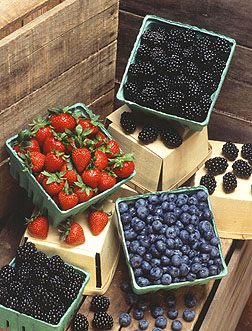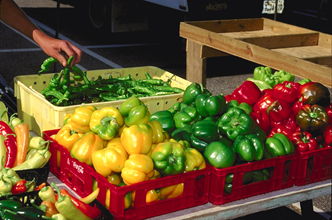
Athletes know that food fuels physical activity. The consequences of not eating enough can be quite dramatic, so we learn quickly to pack that extra energy bar 'just in case.'
But the benefits of the foods we eat go far beyond their ability to fuel our muscles. Some foods contain an amazing array of health-promoting substances, and research suggests they may
- boost immunity
- promote tissue repair
- protect cells from the damage of oxidative stress
- protect against age-related cognitive decline, and
- increase resistance to cancer, heart disease, and other illnesses.
These substances are known as phytochemicals. Although phytochemicals don't provide any energy (calories), essential vitamins, or minerals, they nonetheless should be an important component of any athlete's diet.
So where do you find these wonderful protective compounds? Fortunately, it's easy, tasty, and inexpensive! Phytochemical means 'chemicals from plants', and vegetables and fruits are excellent sources. Which vegetables and fruits are best? Generally most are good bets, but eating a variety of brightly colored produce will help you get the full protective benefit that fruits and vegetables have to offer.
Follow the RAINBOW
Researchers have found that the same phytochemicals that lend vegetables and fruits their vivid colors are also important for keeping arteries healthy, boosting immunity, and fighting disease. So, emphasizing several different colours will help maximize a variety of health-promoting phytochemicals. In many cases, this means eating the colourful skins, often the most concentrated source of protective nutrients.
Several respected researchers have authored books emphasizing the importance of choosing broadly among the richly coloured fruits and vegetables (e.g., "What Color Is Your Diet?" by Dr. David Heber, director of the Center for Human Nutrition at the University of California at Los Angeles and "The Color Code" by Dr. James A. Joseph, Chief of the Neuroscience Laboratory at Tufts University). Although the book titles ring of a 'fad' diet, the science is sound, and colour is something everyone can appreciate.
Even prominent nutrition campaigns are starting to recommend that consumers use colour to help choose produce. For example, a U.S. National Cancer Institute program (www.5aday.com) uses the following colour categories, highlighting the protective compounds predominant in each colour of fruit or vegetable.

R E D
Red fruits and vegetables are helpful to maintain heart health, memory function, a lower risk of some cancers, and urinary tract health. The protective phytochemicals in red produce include lycopene and anthocyanins. Lycopene is a powerful antioxidant that may help reduce the risk of several types of cancer as well as heart and lung disease. Anthocyanins also appear to help control blood sugar and protect against heart disease by preventing blood clots. Some evidence suggests they may slow the aging of cells in the body.
O R A N G E / Y E L L O W
Orange fruits and vegetables are good sources of beta-carotene; an antioxidant that helps reduce the risk of cancer and heart disease, maintain eyesight, help boost the immune system, and promote repair of damaged DNA. Bioflavonoids, also found in orange fruits and vegetables, work with vitamin C to help reduce the risk of cancer, strengthen bones and teeth, heal wounds, keep skin healthy and lower the risk of heart attacks.
G R E E N
Green fruits and vegetables are among the best sources of lutein; an antioxidant that helps reduce the risk of cataracts and macular degeneration, which can cause loss of vision. Green vegetables are also rich in cancer-fighting chemicals like sulforaphane, isocyanate and indoles, which inhibit the action of carcinogens.
B L U E / P U R P L E
Blue and purple fruits and vegetables are rich sources of anthocyanins and phenols. Both of these phytochemicals are currently being studied for antioxidant and anti-aging effects. Research suggests they may help reduce your risk of cancer, heart disease, and Alzheimer's.
W H I T E
Although a white color often suggests less nutrition, there are some exceptions. Garlic, leeks, and onions, are rich sources of allicin, which helps control blood pressure and cholesterol and seems to increase the body's ability to fight infection. Cauliflower contains sulforaphane, and mushrooms contain selenium, both potential cancer-fighting compounds.
Next time you're at the supermarket, let colours guide you through the produce section. And don't be shy when filling up your cart, since many experts now recommend eating between 5 and 10 servings of fruits and vegetables a day for optimal health (a serving is roughly equivalent to 1/2 cup chopped up fruit or vegetable). Buying more colorful vegetables and fruits is the first step to making your next meal a vibrant palette of healthful foods.


